#British isle collapse
Note
Hey bestie whats a narrow boat? I saw you tag that on something you reblogged and I'm pretty curious now!



- Terry Darlington, Narrow Dog to Carcassone
A narrowboat (all one word) is a craft restricted to the British Isles, which are connected all over by a nerve-map of human-made canals. To go up and down hills, the canals are spangled with locks (chambers in which boats can be raised or lowered by filling or emptying them with water.) As Terry says above, the width of the locks was somewhat randomly determined, and as a result, the British Isles have a narrow design of lock - and a narrowboat to fit through them. A classic design was seventy feet long and six feet wide. Starting in the 18th century, and competing directly with trains, canal “barges” were an active means of transport and shipping. They were initially pulled along the towpaths by horses, and you can still see some today!
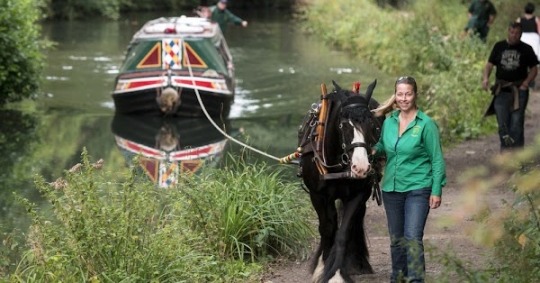
Later, engines were developed.
Even after the trains won the arms race, it was a fairly viable freight service right up until WW2. It’s slow travel, but uses few resources and requires little human power, with a fairly small crew (of women, in WW2) being capable of shifting two fully laden boats without consuming much fossil fuel.
In those times the barges were designed with small, cramped cabins in which the boaters and their families could live.
During its heyday the narrowboat community developed a style of folk art called “roses and castles” with clear links to fairground art as well as Romani caravan decor. They are historically decorated with different kinds of brass ornaments, and inside the cabins could also be distinctively painted and decorated.
Today, many narrowboats are distinctively decorated and colorful - even if not directly traditional with “roses and castles” they’ll still be bright and offbeat. A quirky name is necessary. All narrowboats, being boats, are female.
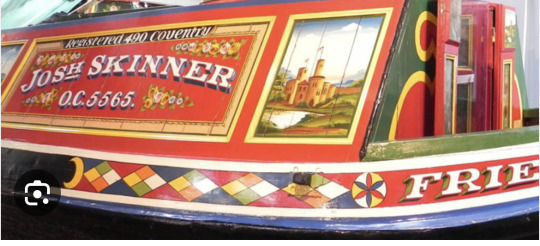

After a postwar decline, interest in the waterways was sparked by a leisure movement and collapsing canals were repaired. Today, the towpaths are a convenient walking/biking trail for people, as they connect up a lot of the mainland of the UK, hitting towns and cities. Although the restored canals are concrete-bottomed, they’re attractive to wildlife. Narrowboats from the 1970s onward started being designed for pleasure and long-term living. People enjoy vacationing by hiring a boat and visiting towns for a cuter, comfier, slower version of a campervan life. And a liveaboard community sprang up - people who live full-time on boats. Up until the very restrictive and nasty laws recently passed in the UK to make it harder for travelling peoples (these were aimed nastily at vanlivers and the Romani, and successfully hit everyone) this was one of the few legal ways remaining to be a total nomad in the UK.
Liveaboards can moor up anywhere along the canal for 28 days, but have to keep moving every 28 days. (Although sorting out the toilet and loading up with fresh water means that a lot of people move more frequently than that.) you can also live full-time in a marina if they allow it, or purchase your own mooring. In London, where canal boats are one of the few remaining cheapish ways to live, boats with moorings fetch the same prices as houses. It can be very very hard for families to balance school, parking, work, and all the difficulties of living off-grid- but many make it work. It remains a diverse community and is even growing, due to housing pressures in the UK. Boats can be very comfortable, even when only six feet wide. When faced with spending thousands of pounds on rent OR mooring up on a nice canal, you can see why it seems a romantic proposition for young people, and UK television channels always have slice-of-life documentaries about young folks fixing up their very own quirky solar-powered narrowboat. I don’t hate; I did it myself.
If you’re lucky, you might even meet some of the cool folks who run businesses from their narrowboats: canal-side walkers enjoy bookshops, vegan bakeries, ice-cream boats, restaurants, artists and crafters. There are Floating Markets and narrowboat festivals. It’s generally recognised that boaters contribute quite a lot to the canal - yet there are many tensions between different kinds of boaters (liveaboards vs leisure boaters vs tourists) as well as tensions with local settled people, towpath users like cyclists, and fishermen. I could go on and on explaining this rich culture and dramas, but I won’t.


Phillip Pullman’s Gyptians are a commonly cited example of liveaboards - although they were based on the narrowboat liveaboards that Pullman knew in Oxford, their boats are actually Dutch barges. Dutch barges make good homes but are too wide to access most of the midlands and northern canals, and are usually restricted to the south of the UK. So they’re accurate for Bristol/London/Oxford, and barges are definitely comfier to film on. (Being six feet wide is definitely super awkward for a boat.) but in general Dutch barges are less common, more expensive and can’t navigate the whole system.

However, apart from them, there are few examples of narrowboat depictions that escaped containment. So it’s quite interesting that there is an entire indigenous special class of boat, distinctive and highly specialised and very cute, with an associated culture and heritage and folk art type, known to all and widely celebrated, and ABSOLUTELY UNKNOWN outside of the UK - a nation largely known around the world for inflicting its culture on others. They’re a strange, sweet little secret - and nobody who has ever loved one can resist pointing them out for the rest of their lives, or talking about them when asked to. Thank you for asking me to.
6K notes
·
View notes
Text
deep in the obsession
ok so IDK how much I've talked about my Special Interest in the Bronze Age on here. At one point (like nanowrimo of 2003 or so) I was trying to write a novel set in the British Isles Bronze Age and I researched as much as I could and there just wasn't much information and I wrote some stuff anyway but it petered out. And ever since then I've kept checking back on various avenues of research and every time there's a new find I'd read as much as I could find about it. And then they discovered the remains of a pile-dwelling settlement in the Fens in England and they've finally just now published the results of that? Well of course I've been obsessively reading about it. (I had actually emailed the Cambridge Archaeology Unit a couple of months ago to ask where I could find the publications, so the timing was good.)
I mean the long and short of it is, they've got a site exposed by modern quarrying activity, which consists of five remaining buildings, which burned down and collapsed into the river channel with all their contents in the 9th century BC; the inhabitants escaped with very few of their possessions, and the rest of the assembly of the items they used in their daily lives are largely present, very well-preserved; whole sets of pots and woodworking tools, as well as textiles and textile-processing materials, foodstuffs, wooden tools, and enough building materials to almost entirely reconstruct their dwellings; a enormous wealth of information about their diets, their ways of living, even some feel for their aesthetic sensibilities. The circumstances of the buildings' collapse even means we know how they laid out their living spaces.
So I am going to infodump about what I've pulled out of these rather dense and dry reports (I have zero complaints, they're perfectly appropriately-written), so buckle up.
Firstly, if you want to read these yourself, the publications are open access PDFs hosted on the Cambridge Archaeology Unit's website here.
There are also a fantastic series of blog posts both from during the excavation and from during the initial analytical "post-ex" phase on the site's website, which I devoured while waiting for the final reports.
I admit I was first drawn to the whole thing, when I first saw stories about it, because of the mystery. It seems to have been a whole settlement, a village maybe, and it all burned down at once, and no humans seem to have died in it, but everyone left everything behind, even leaving a dog in one of the buildings, and some penned little lambs in a couple of them-- what caused this? Were they attacked? Were they forced out of it? It had a palisade around it as if for defense, did they build it because they were afraid, and rightfully so?? Why did they not come back to try to salvage anything? The water would have been shallow, surely they could at least get their axe-heads and things back.
But the thing that has sustained my interest now is that it appears to have been an unexceptional village after all. There's no evidence that these were elite people living here. There weren't any unambiguous weapons found-- part of a broken sword, in what was obviously a recycle bin (a wooden bucket), waiting along with some broken chisels and a bent axe and part of a broken bronze bucket for a trip back to the nearest metalworker. Some spears, but likely used for hunting, stored outside the houses all together leaned up against the palisade under an overhanging roof eave. Axes, but the sheer quantity of woodworking in the site means they were very obviously woodworking tools, and weapons only by technicality.
Other contemporaneous sites are preserved so incompletely that there are always "was this a place people dwelled or was it a ceremonial gathering place" kinds of questions. Artifacts are found either discarded in middens, broken, or deposited in hoards, "ceremonially?". But all this stuff is in-context, in the house, which burned down and collapsed straight down. This was the kitchen area, obviously; all the houses had most of their pots in the same approximate spot, caches of grain in the same area. This corner is where we find stuff they were working on-- one house has probably a loom, and tons of textile-related stuff scattered around it. (There's only evidence for a loom in one or maybe two of the buildings, but there are spindle whorls and bobbins of thread in three; several spinners providing one weaver, as is common throughout history.)
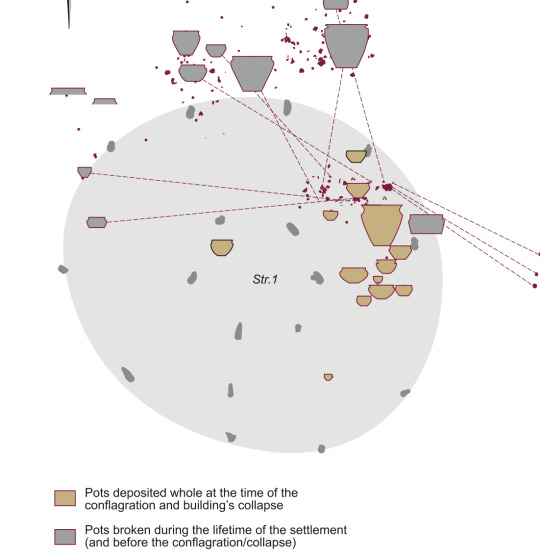
Some of the pots had been broken before the fire, and some of them had been partially discarded and partially kept, like for example a well-shaped broken bit of rim was being used as a scoop or something, while the little unusable shards had gotten chucked into the river where they threw their trash; the archaeologists could reunite fragments to prove this, and could derive the information that these shards would all be associated with the same house; they weren't shared, they were using the broken pot in the same house where they'd used it before it was broken; they seem to have cooked their meals separately, and kept separate inventory of basic household necessities. But the extra stuff seems to have been stored in the communal storage shed, so they could all get to it.
There's a large but incomplete sheet of bark that in places has a second sheet adhered to it with moss in between, which was likely bedding.
There are textiles, not just woven ones but also weft-twined ones made from lime bast cord-- mats, or hats, or capes. There's a knotted fishing net that was rolled up and in a pile with other things in an area that seems to have been a storage shed of sorts. (Near the "recycle bin" full of broken metal.) There's a collection of prepared fiber, ready to be made into cordage or spun into thread, and it's all prepared the same way in standard-sized bundles-- tantalizingly, regular enough as if for trade, stored in that storage shed next to a nested set of new pots-- like somebody had bought or made them and they weren't put to use yet, OR someone had made extra they intended to trade offsite for stuff they couldn't make themselves.
The whole sets of pots are broadly the same among households-- similar numbers of large vs. small, coarse vs. fine. They all resemble one another, though some are better-made than others-- as if several people made them, but under the guidance of one experienced worker.
Several pots and wooden containers have food residues. Hauntingly, there's a ceramic pot that was still half-full of porridge, with a wooden spatula/spoon still stuck in it. The porridge was made of ground wheat cooked in a liquid containing animal fats from a ruminant-- either sheep/goat or red deer-- possibly an early example of frumenty.
Enough of the structural timbers remain from the buildings, many with markings on them from where other structural elements were touching them and alternately exposed/protected them from fire so it is possible to reconstruct shapes and connections in more detail than if they were unburnt ruins, that the buildings can be nearly completely reconstructed, which is novel because most buildings of this era are known only from footprints/post holes. Almost no material survived from the walls, but because of these ghost "protection marks" it's possible to know that the walls existed, how wide they were, that they were attached in a particular spot, that they were made of a series of small uprights-- and to then surmise that some of the fragments of "wattle", woven panels, must have come from the walls in some cases. And it's possible to reconstruct the innovative, never-elsewhere-seen sprung floor system of bowed joists that kept the floors securely above the water below.
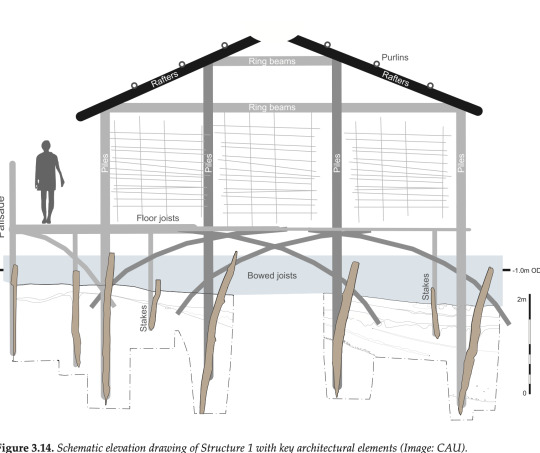
Anyway, I've devoured Vol I and am most of the way through scouring Vol II for interesting tidbits.
Yes of course I want to write a novel with this as the setting but I also am just completely fascinated.
100 notes
·
View notes
Text
Caribbean cruise vacations have a long violent history. Earlier today, I came across one of the early print advertisement illustrations for the Caribbean cruise ship vacations offered by “the Great White Fleet.” And I pondered bananas.
Just as uncomfortable as it sounds. The story of the origin of the Caribbean cruise industry is, after all, also the story of the origin of the term “Banana Republic.”
In 1914, the Great War began as the planet’s powerful empires of old were collapsing, as British, French, Austro-Hungarian, Ottoman, Russian, and Qing/Chinese powers were marred by internal revolt and global warfare. But in 1914, the United States completed their Panama Canal and consolidated power in Latin America and the Caribbean, celebrating the ascent of a “new” empire made strong, in part, by bananas.



As of 2022, bananas generate 12 billion dollars per year, with 75% of bananas exported from Latin America and the Caribbean.
The planet’s single biggest banana-producing company is Chiquita. The Chiquita brand was previously known as United Fruit Company, which had essentially monopolized the banana industry in Latin America. United Fruit Company has a bit of an image problem, following its theft of Indigenous land across Central America in the early 20th century; its role in provoking the killing of tens of hundreds/thousands of plantation laborers during the Banana Massacre of 1928; the company’s direct role in the CIA-backed toppling of the Guatemala government in the 1950s; and the company’s role in paying to harass and intimidate labor organizers in Colombia in recent decades.
But what of the “romance” and “adventure” of the Caribbean?
So it’s 1915 or 1916.
Middle of the Great War. Classic empires are disintegrating: Spanish empire, British empire, Austro-Hungarian empire, Russian empire, Ottoman empire, remnants of the Qing/Chinese state, etc. And whose empire is rising? United States, an empire expanding in the Caribbean, Central America, and South America. After the 1898 Spanish-US war, as Teddy Roosevelt’s cartoon cavalry conquered Cuba, the Spanish Main belongs to the US of A. The US Navy controlled the Caribbean Sea, and was aiming to expand across the Pacific Ocean, to Hawai’i and beyond.
But the official US Navy isn’t the only fleet upholding the empire. The United Fruit Company had its own fleet.
The text of one of these Great White Fleet ads, from 1916, adorned with imagery of a blue-and-gold macaw and an aerial map of the Caribbean, reads:
“[W]here winter never comes and where the soft trade winds bring renewed health. [W]ith all the comforts and all the luxuries of life you enjoy aboard the palatial ships of the GREAT WHITE FLEET. Delicious meals a la carte [...]. Dainty staterooms, perfectly ventilated [...]. [A]mid the scenes of romance and history in the Caribbean. And with it the opportunity to win for yourself a treasure of health and happiness, of greater benefit than the fabled fountain of youth, sought by Spanish adventurers in the tropic isles of the Spanish Main.”
Who’s leading the charge?
The United Fruit Company!

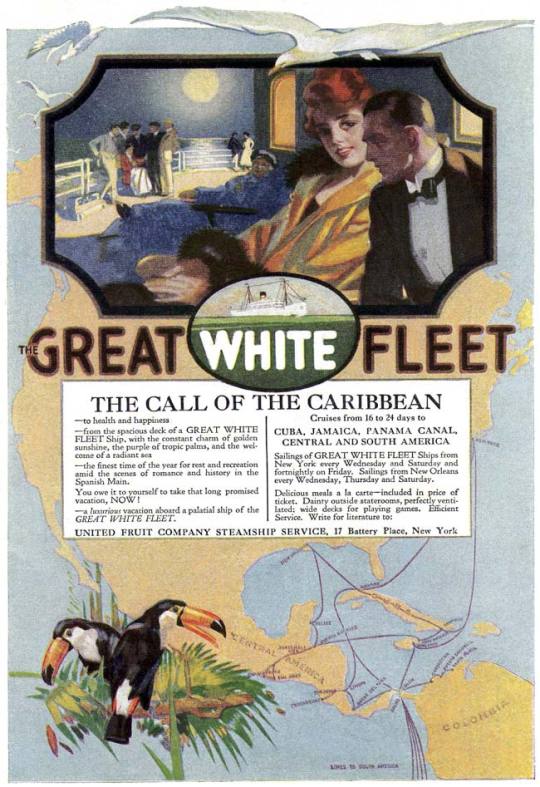
From the May 1916 issue of Red Book. Image source, from Archive dot org:

Another:
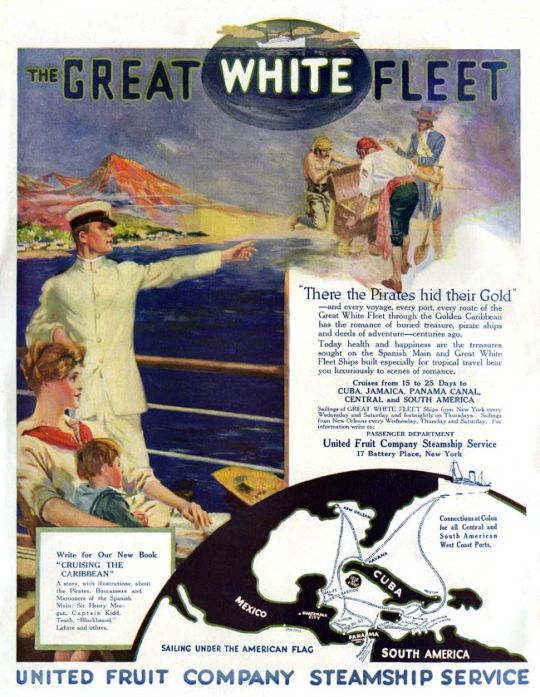
Image source, from Archive dot org:

“There the Pirates hid their Gold -- and every voyage, every port, every route of the Great White Fleet through the Golden Caribbean has the romance of buried treasure, pirate ships an deeds of adventure [...].”
The Golden Caribbean.
The same region where Columbus murdered Indigenous people, where the US and France had just spent 100 years punishing Haiti with unending economic warfare afters slaves rebelled against colonization, and where the United Fruit Company would now set up shop.
The company’s plantations would expand across Central America, establishing brutal racial hierarchies and essentially controlling federal governments of Central American nations.
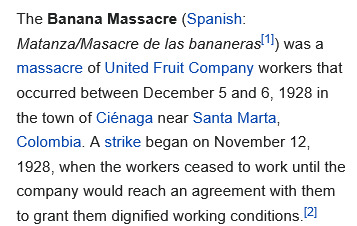
In 1928, over 30,000 laborers were on strike at banana plantations in Colombia. They demanded payment of actual wages, rather than the credits they were given which were mostly only redeemable at company-owned stores in company towns. The US government threatened to send the Marine Corps to intervene if the “subversive” workers would not return to UFC’s plantations. In December 1928, after martial law had been declared, General Cortes Vargas entered the town square of Cienaga (Magdalena) during Sunday gatherings, with machine guns, opening fire on the crowds, and killing perhaps 3,000 people.
In the late 1940s, the United Fruit Company intensified its ad campaigns led by propagandist Edward Bernays (nephew of Sigmund Freud???), who also practiced his skill at manipulative advertising when working to popularize the American Tobacco Company by showing women smoking “torches of freedom” and linking “women’s rights” to cigarette iconography.
Bernays, who explicitly wrote about his “counter-Communist” intention in the ads, was “drafted” in the war to topple ascendant leftist governments. After 1944 and after Arevalo’s labor reforms, Jacobo Arbenz Guzman took control of Guatemala in 1951, and took over 200,000 acres from United Fruit Company and returned them to poor families. Bernays launched propaganda attacks against Guatemala, helping to plant stories about Guatemala eventually carried in the Saturday Evening Post, New York Herald Tribune, and Reader’s Digest. In January 1952, Bernays personally led a tour of Central America, accompanying publishers and editors of Newsweek, the Miami Herald, the San Francisco Chronicle, the Cincinnati Enquirer, Scripps-Howard, and Time magazine. When the CIA-trained military force led by Carlos Castillo Armas invaded Guatemala, with CIA aerial support, installing Castillo Armas as president, Bernays called them an “army of liberation.”

Bananas and Caribbean cruises aren’t the only culprits in expanding imperial power in Latin America, the tropics, and the Global South.
In 1914, the same year that the United States finished the Panama Canal and consolidated power in Latin America and the Caribbean, Richard Strong was a newly appointed director of Harvard’s new Department of Tropical Medicine. Strong was also appointed director of the Laboratories of the Hospitals and of Research Work at United Fruit Company. Strong toured the company’s plantations in Panama, Costa Rica, Guatemala, Honduras, and Cuba. In the coming years, Strong would also personally approach Harvey Firestone, chief executive of the Firestone company, which owned and brutally operated rubber plantations in tropical West Africa. Research in tropical medicine was thus inaugurated by and dependent on colonial/imperial plantations and racial/social hierarchies at United Fruit Company and Firestone sites across the tropical regions, planetwide. Strong is just one character that demonstrates the interconnectedness of academia, fruit plantations, rubber supplies, food distribution, motor vehicle industries, strike-breakers, military forces, imperial expansion, and other tendrils of violently-enforced racist power.
Today, in 2022, Chiquita maintains twenty thousand employees across 70 countries.
I think about this as I eat a banana for lunchtime. I think about this when I see the Edenic portrayal of a Caribbean shore, a landscape baked not so much by the tropical sun but instead scarred by centuries of genocide, slavery, and plantation labor, where government officials gleefully report “with honor” on the massacre of thousands.


“Just a banana, it ain’t.”
Agreed.
336 notes
·
View notes
Text

Presenting the LBSCR A1/A1x terriers! in 30 liveries.
Here is a list of the liveries and locos. They will be listed left to right, top to bottom.
1. Stepney in 1960s preservation/RWS condition IEG
-preserved irl
2. Kemptown in Original IEG (or close to it)
-She was sold to a colliery and preserved in the 70s
3. Martello in Southern Olive
-preserved irl
4. Abigail (Wandle) in AF&JR Blue
- @angryskarloey 's OC, see their fics for info
5. Freshwater in FYN Green
-preserved irl
6. Deptford in NER Green
-sold to a factory, survived the factory being bombed in 1915, was sold to the NER to replace a 'destroyed' E1 (Thomas in my AU), sold to the NWR in 1923
7. Minories in NWR Blue
-sold to the NWR in 1933
8. Carisbrooke in Southern Machalite
-bought for a Musuem in 1959
9. Nicola (Piccadilly) in AFJR Blue
-See @angryskarloey
10. Beulah in DWR Black, 2-4-0 condition
-purchased by the DWR in 1934, expirementally rebuilt back into a 2-4-0
11. Thomas (fictional addition) in NWR (rebuilt) Blue
-fictional addition to the class, just to have Thomas as a terrier
12. Cheapside in LB&SCR Umber with white lining
-purchased in 1951 at scrap price by Suddery Rail Museum after withdrawl due to broken crank axle, restored and serves as pilot at musuem. Livery was proven to be historically inaccurate, but She prefers it, so was allowed to keep it.
13. Brighton Works in Brighton Pilot livery
-Stolen by Caomhnóir in 1963, later restored by the Bluebell
14. Portishead in GWR Shirtbutton Green
-disappeared from Swindon in 1950, reappeared at the KESR in 1978
15. Ashted in WC&PR Green
-sold into industry, bounced around the NCB till the 80s, then purchased by the KESR in 1976
16. Fenchurch in LBSCR Umber
-Preserved irl
17. Bodiam (Popular) in KESR Blue 18. Sutton in Worn Grey
-Preserved irl
19. Waddon in SE&CR condition post-war Green
-Preserved irl
20. Boxhill in LBSCR 2-4-0 Condition IEG
-Preserved irl
21. Whitechappel in BR Lined Black
-Preserved irl
22. Clapham in LSWR Mint
-bought for spares for Kemptown. Purchased alongside kemptown and rebuilt in the 80s
23. Knowle in Southern Black
-Preserved irl
24. Newport in Isle of Wight Central Railway Red
-Preserved irl
25. Leadenhall in New Haven Harbor Co.
-purchased by the New Haven Harbor Co. to work alongside Fenchurch. Preserved direct from British Railways in 1962
26. Millwall In DWR rebuilt condition
Purchased by the DWR in 1934. Due to her boiler being little better than scrap condition, she was fited with a DWR D1 type boiler.
27. Zephyr (Wapping) in streamlined condition
-striped for parts to repair Popular in 1938, but her frames were saved by an eccentric Railway director, who loved the terriers. Rebuilt as his personal engine and given cosmetic streamlining, she was purchased from BR following his retirement, was stored in a dedicated room in his home until his death in the 80s, when she was donated to the Bluebell as per his will.
28. Earlswood in DWR 0-4-2 condition
-purchased by the DWR in 1949, experimentally rebuilt as an 0-4-2
29. Tooting in C&HR Blue
-Purchased by the C&HR in 1901 for service on a coastal branchline, which she still runs to this day.
30. Brixton in Caledonian Blue
-sold to a colliery in 1935, purchased by the Caledonian preservation Society in 64 to serve as a shunter in their works.
*collapses*
22 notes
·
View notes
Note
I guess what I mean is... if so many of the old gods of Europe were only mentioned by iffy sources (i.e. Christian monks), then how do we know what IS written about them isn't just Christian nonsense?
Well the short answer is heavy scholarship.
The long answer is that through scholarship we can actually glean a lot about the pagan practices from the written sources. The monks (generally) weren't interested in being deceiving about the myths and practices they were writing about. Some are obviously Christian influenced, like the book of invasions for example. They add the lineage to Noah (as a way of making the Irish peoples 'authentic' in the new church) but the other stories appear to be left more or less untouched and can therefore pretty safely be assumed to be from the pagan oral history. So in this example we can pick out the obvious Christian influence and continue on. Some Christian adjustments are reflections of the writers simply not understanding what they're recording anymore, most surviving manuscripts are from the ~11th-12th century but they have chunks of text from much earlier centuries. By the time the copiers of the surviving texts got to the sections of pagan information they generally had absolutely no idea what was being talked about anymore and just did their best to make it understandable to their readers.
Early Christianity in Ireland (and other insular Celtic areas) is also pretty fascinating because they pretty much were left to their own devices in the power void left by the collapse of Rome so they just adapted their existing faith beliefs to the new god. Later in around the... I want to say 11st century... When the Roman Church really started gathering them back into the orthodox fold higher ups were VERY concerned about a number of "blasphemous" teachings they were hearing about out of Celtic peoples. There are letters from various Roman officials voicing these concerns to leaders of different diocese in the British Isles and basically being told back "look... its unorthodox but I promise they really DO believe in God and the Church, they're just... weird out here..." and I know of at least one missionary that was excommunicated (I want to say someone petitioned to have it reversed) because of their "heretical" teachings. So there is actually a lot that can be gleaned about pagan teachings by looking at the early church in that area as well; which can always be cross referenced with the literary and law practices for continuity.
Lastly there is archeology which can sometimes back up the information we know from writings or bring new light to various practices (like human and animal sacrifices or what areas saw routine festival practice)
I hope that clears things up some. Obviously other areas of pagan Northern Europe have slightly different transitions and writing histories but generally speaking these kinds of scholarship and cross referencing can be applied in each
#ask#anon#pagan#paganism#polytheists#polytheistic#polytheism#history#scholarship#academic research#reconstructionist#reconstructionism#celtic reconstructionism#celtic reconstructionist#irish reconstructionist#irish reconstructionism
15 notes
·
View notes
Text
The Mimicking of Known Successes

The Mimicking of Known Successes by Malka Older
i will happily admit that i had a long Sherlock Holmes phase precipitated by the BBC's Sherlock. that phase ended fairly abruptly when the Sherlock show and fandom simultaneously crashed and burned, or at least that's how it felt to me; i was so turned off by the whole thing that i didn't revisit ANY Holmesian books or media for years afterward, even though i liked quite a lot of it. i've dipped back in a bit since then (because it's hard to resist the charms of Enola Holmes), and am slowly remembering what i loved about the original stories.
this book has all of that charm and then some. honestly what could be more up my alley than wlw Holmes and Watson in a post-environmental-collapse-of-Earth future in space?? literally nothing, it's a perfect book for me. Malka Older really captures everything that makes the original Sherlock Holmes so delightful to me! the first person narrative, for one, which is pitch-perfectly Watsonian in vocabulary and tone, both nostalgic and totally readable. the excellent chemistry and dynamic between Mossa and Pleiti is also spot on, pleasantly messy and immediately fond and entirely satisfying. and the mystery! i loved that the mystery was driving the plot but that the emotional story was the more important arc, and i loved that i had a sense of how the pieces connected but didn't understand it all until Mossa put it together, which is just how a Holmesian story ought to feel.
a fantastic read, and a quick read too, and i'm DYING for the next one (already requested it on NetGalley even though it comes out pretty soon...)
the deets
how i read it: @digger1649 literally put the hardcover into my hands as i was picking up other books at the library and said "you should read this," and he was correct. thanks for all the absolute banger recommendations lately!!! this is one i will definitely buy for myself and recommend at work.
try this if you: are a Holmes fan of any stripe, dig a queer mystery, love sff that imagines what we'll do after running the Earth into the ground, or just delight in the interesting combo of old-fashioned gaslamp language/tone and a futuristic setting!
some bits i really liked: i just love them and also the references so much
Mossa waved that aside. "But you also know me, and how I work. Explaining it to someone else would take too long."
I could not restrain a feeling of warmth as if that were praise or even affection and not merely a statement of fact.
Believing in signs of affection from Mossa was a trap, because it led to expecting signs of affection.
---
"And you were saying about your specific project?"
"Ah yes. I study the British Isles, in the mid-twentieth century. At the moment I'm working on a very useful book about rabbits and their adventures. There's a wealth of descriptions of the flora and fauna in a highly circumscribed, clearly-identified area."
---
Mossa's expression was like the one she had worn in theoretical forestry class when the professor had offered successively more difficult elimination problems until Mossa, alone, had comprehended the final paradigm: as though I were as fascinating and satisfying to grasp as her most difficult questions. But then she shook her head.
"Pleiti," she said, "I haven't changed."
---
Mossa responded simply with a Classical quotation: "'Why are men?'"
#books and reading#book reviews#book recs#booklr#bookblr#queer sff#the mimicking of known successes#malka older
5 notes
·
View notes
Text
Spoiler Warning!
(for a series which ended 10 years ago, and on a Tumblr page almost entirely populated by die hard fans, but still)
Wolverines
One of the first things we learn in this series is that The Forest is overrun with Wendron Witches and Wolverines. I've been re-reading the series, and am about to start Queste for the hundredth time, but I've only just realised how weird the wolverine thing is.
For one thing, wolverines don't tend to live in forests, at least not temperate ones like The Castle's Forest, they prefer taiga tundra, and colder climes altogether, somewhere more like place where Snorri's from, or the region around the House of Foryx.
For another thing, The Small Wet Country Across The Sea, the country the Castle is in, is heavily based on Britain, specifically Cornwall where Angie Sage lives. Wolverines are not, and have never been, native to the British Isles at all, let alone Cornwall.
So, why are there wolverines? I realise that some kind of danger in Forest was necessary, but why make it wolverines specifically? Why not wolves which's pack tactics and predatory behaviour - the wolverine is mainly a scavenger - would be better fit for the animals we see? I mean even Wolf Boy, the feral child raised in part by wolverines, is called 'Wolf' Boy, not 'Wolverine' Boy. It's just weird.
(spoiler bit)
Except, it it? We discover in Fyre that the whole series takes place in the future. Might the inexplicable appearance of wolverines foreshadow this? And, going further, might the fact that these wolverines are far south of the regions they live in in our Time suggest something about what separates Sep's Time from 'The Time Before' AKA our Time?
It is heavily implied that Magyk is actually advance technology, but that the people of this Time aren't particularly advanced, they live in a medieval-esque world, and have done for a while. Clearly something happened to change society dramatically, with Magyk being the legacy of the technological past.
This is where the wolverines come in. For wolverines to live in the Castle's Forest, the entire region must be colder than it is in our Time - we know this is case as The Castle sees heavy annual snowfall at the time of the big-freeze, which is not so common in the Cornwall we know. So we're looking at some kind of environmental disaster, which led to the collapse of much of the society and technology of The Time Before.
What might this be? An ice-age? A nuclear winter? The entire planet drifting away from the sun? Your thoughts please.
27 notes
·
View notes
Text

Lincoln Cathedral
Lincoln Cathedral, Lincoln Minster, or the Cathedral Church of the Blessed Virgin Mary of Lincoln and sometimes St Mary's Cathedral, in Lincoln, England, is a Grade I listed cathedral and is the seat of the Anglican Bishop of Lincoln. Construction commenced in 1072 and continued in several phases throughout the High Middle Ages. Like many of the medieval cathedrals of England, it was built in the Early Gothic style.
Some historians claim it became the tallest building in the world upon the completion of its 160 metres (525 ft) high central spire in 1311, although this is disputed. If so, it was the first building to hold that title after the Great Pyramid of Giza, and held it for 238 years until the spire collapsed in 1548, and was not rebuilt. Had the central spire remained intact, Lincoln Cathedral would have remained the world's tallest structure until the completion of the Washington Monument in 1884. For hundreds of years the cathedral held one of the four remaining copies of the original Magna Carta, now securely displayed in Lincoln Castle. The cathedral is the fourth largest in the UK (in floor area) at around 5,000 square metres (54,000 sq ft), after Liverpool, St Paul's and York Minster. It is highly regarded by architectural scholars; the Victorian writer John Ruskin declared: "I have always held ... that the cathedral of Lincoln is out and out the most precious piece of architecture in the British Isles and roughly speaking worth any two other cathedrals we have."
23 notes
·
View notes
Text
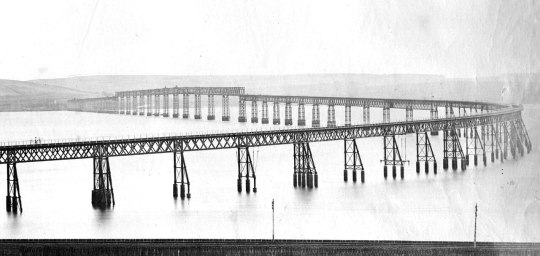
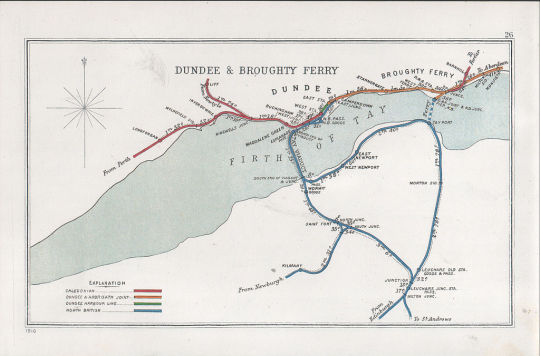

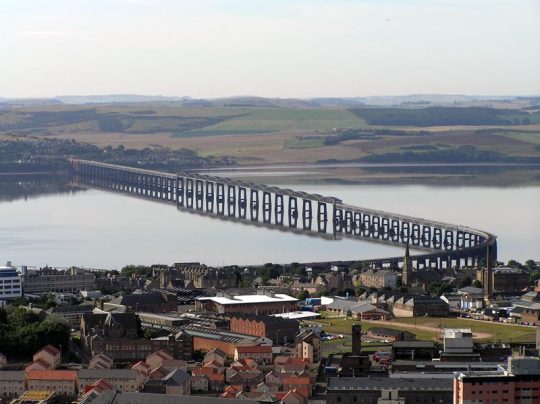
On June 20th 1887 the "new" "Tay rail bridge opened, the longest in the British Isles.
Firstly let’s get the usual dates thing out the way, I have three dates for this after examination, 1st, 10th and 20th of June, you’d think in an age where we photograph things for posterity, we could get the dates right. I’ve chosen today because it flagged up in my alerts, it’s as simple as that.
We have to salute the bravery of those men who worked building bridges like this, I say men, but look t the photos of the construction workers and see how young some of them were!
I think we all know the story behind the Tay bridge disaster so there is now need to go through it all again but after the bridge collapsed the North British Railway and supporters of the Tay Bridge were determined that it should be rebuilt. William Henry Barlow who had sat on the board of enquiry into the old bridge was asked on the best course of action. After thorough investigation of the options, his recommendation was to build a new double line bridge, completely independent of the old.
Barlow’s design for the new bridge was deeply influenced by the presence of the old. To satisfy stipulations made by the Board of Trade, the bridge was to be constructed exactly parallel alongside the old in order to keep navigation channels open, and its height was to be reduced from 88ft in the old bridge to 77ft in the new. As in the old bridge, the railway line was to run on the top of the approach girders, and through the girders of the high, larger navigation spans. Barlow recommended that if the spans of the new bridge were to be kept the same, girders from the old bridge that were unaffected by the collapse of the high girders, were able to be re-used in the new.
The new bridge was to be built 60ft upstream from the old, allowing the old bridge to become ‘staging’ for the men and materials in the construction of the new. The approaches onto the new bridge were altered; to the south the branch lines were joined on brick arches nearer to the shore at Wormitt, and to the North the eastwards curve into Tay Bridge Station (now called Dundee) was softened. Stringent tests on weight and wind loading in the design and construction of the new bridge were also to be undertaken. The proposals for the ‘New Tay Viaduct’ were accepted by Parliament in October 1881, and the firm William Arrol & Co of Glasgow was appointed contractor.
The new bridge took just 5 years to build, thanks in most part to special pontoon equipment with hydraulic legs which were designed by William Arrol. Various arrangements of these hydraulic pontoons were used to sink and construct the brick and concrete foundation columns, to erect the wrought iron piers, to move the old girders into position for the new bridge, and to erect the new navigation spans. The completed bridge is 10711ft in length, 8396ft of which is in a straight line running virtually north / south across the Tay until it curves eastwards towards Dundee. There are 85 piers; 1-28 forming the south approach, 28-41 the ‘navigation spans’ and 41-85 the north approach. The new Tay Bridge was opened to traffic, without ceremony on 20th June 1887.It still stands as testament to what good engineering was used in it's build.
You can find loads more pickoff the bridge during construction here https://www.leisureandculturedundee.com/virtual-gallery-new-bridge-1887
15 notes
·
View notes
Text
thinking about my ancestors on pancake day while i eat well, as per usual.
i think back to my ancestors 300 years ago. some were already settlers on others' land, and some lived in the British Isles and some in Bohemia and many doubtless in other parts of Europe. 300 years is around 15 generations, 2¹⁵ ancestors--that's 32 THOUSAND people. obviously the real number is smaller because of pedigree collapse (people marrying 2nd or 5th or 10th cousins) but still. all those people in the world i am descended from! some were not good people, but many of them were good, or tried to be. they were fishermen and servants and merchants and prostitutes, queers and bastards and priests and cowherds. there were so many! it boggles the mind.
#some have done very well by me#i hope they think of me. i hope they are proud of me#and I pray for the forgiveness and reparation of the many sins they committed against others#shrove tuesday#mardi gras#ancestor worship
5 notes
·
View notes
Text
i’m playing ck3. anglo-saxon pagan. my immediate goal is forming the north sea empire.
anyway, i just noticed one of my norse vassals isn’t asatru. they’re not even christian.
they’re bori. i don’t even know what that is. i had to look it up. apparently it’s some west african animism. and i was curious why this minor nobleman in scandinavia was practicing a west african faith. and i realized both of his parents were also “bori” and his grandparents and then his great grandparents.
that’s when i realized....bori is spread throughout eastern europe and siberia. apparently some ruler of the khazar khaganate like over a century ago had converted to bori (i don’t know how or why -- i see no west african people in their dynasties) and it’s just been slowly spreading ever since. the khaganate eventually collapsed and all of its many successor kingdoms are also lead by khazars who practice bori.
and i also noticed even further east the rest of siberia is almost entirely islamic. tengrism is nearly extinct except for a couple of holdouts.
and the funny thing is the territories where bori comes from (west africa) is now almost entirely catholic. bori itself is nearly extinct in west africa.
and i’m slowly but surely converting europe to germanic paganism. i’ve already got the british isles, scandinavia, northern germany, frisia, and i just conquered provence, genoa, corsica, and rome. so they should be asatru soon enough. and when i finally dismantle the papacy the rest of europe should follow.
which means west africa will become the last stronghold of catholicism. and eastern europe/siberia will become the last stronghold of bori.
5 notes
·
View notes
Text
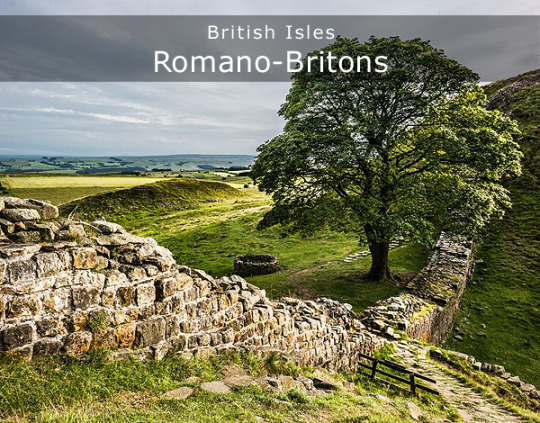
New Banner Feature:
Post-Roman Britain: the post-Roman period in Britain was one of gradual social collapse in the face of unstoppable invasion, with a series of small states or kingdoms emerging and falling in the space of two centuries.
#history#historyfiles#post-roman#post-roman britain#britain#Romano-Britons#Romano-British#Anglo-Saxon#invasion#migration#migrants#kingdoms#king arthur#ambrosius aurelianus#vortigern
2 notes
·
View notes
Text
27th October
St Odran’s Day

Source: AnaStPaul website
Today is St Odran’s Day. Odran was a sixth century Irish bishop and missionary who was a close companion of St Columba. The legend surrounding his death is one of the most extraordinary of that of all the early Christian saints. Columba built a new church on the island of Iona, but its foundations would not take. The only remedy for the collapsing building Columba could come up with was human sacrifice. Odran, by now an elderly man and who had long debated the nature of the afterlife with his mentor, volunteered to be the sacrificial victim, reasoning that this way he would find out the truth about Heaven and Hell. Odran was duly buried alive in the church’s new foundations. Sure enough, afterwards, the building stayed intact, so Columba ordered that Odran be retrieved from the ground. The monks dug and revealed the saint’s head, which immediately began talking, giving the nuanced message that Heaven was not all that it was cracked up to be and that the denizens of Hell were not universally miserable. Columba immediately brought an end to this heretical revelation by ordering the monks to cover his friend’s head before he could say any more.
Hunan sacrifice was most definitely not part of Christian tradition, but pagan religion frequently ensured the safety of new buildings by the killing of animals (and presumably before that, of humans) and burying them in the foundations. One can only assume that the story of Odran’s death was a repurposed pagan Celtic tale, which makes it a genuine curiosity. The fact that the story has a philosophical aspect only makes more intriguing.
This month also saw the brewing of the mighty October Ale in households across the British Isles. Fabulously strong, it was only brought out rarely in the autumn and winter months to warm the bellies of its drinkers, being kept locked away for the rest of the time.
2 notes
·
View notes
Text
...Tintagel, immortalised in British mythology as the place of King Arthur’s conception, is one of a string of castles at risk of tumbling into the sea as climate change increases the pace of coastal erosion.
English Heritage has launched a fundraising appeal and identified its six most vulnerable castles, warning that some of England’s most beloved spots may be lost if nothing is done.
Rob Woodside, the director of estates at English Heritage, said: “Erosion along England’s coastline is nothing new but the rate of land loss that we have seen over the past few years is alarming. Rising sea levels and more regular storms pose a real risk to the future of many of our sites.”
Chunks of Tintagel have long fallen into the sea but parts of the cliff directly in front of the visitor centre have recently been lost to erosion, eating into a viewing area and coastal path.
Other sites at risk in the south-west of England include Bayard’s Cove Fort, built in Tudor times to protect Dartmouth in Devon. It is set on a terrace cut from the rocky riverbank, a beautiful location but one prone to flooding. English Heritage says work is urgently needed to investigate the impact of rising sea levels.
Off the Cornish coast, English Heritage is also concerned about the garrison walls in St Mary’s, the largest of the Isles of Scilly. They were built after the attack of the Armada in 1588 due to concerns that Spain would send a second fleet.
But the sea is now more of a threat than enemy forces, with the shape of the walls creating pinch points, or “armpits”, where the tide’s power is focused.
English Heritage is also concerned about Piel Castle in Cumbria, set on a low-lying island about half a mile from the coast in Morecambe Bay. Much of the island has already been lost and the castle’s keep is at risk.
Two castles in Hampshire are under threat. Calshot, built by Henry VIII, is considered at risk, with work needed on a spit and foreshore.
Part of Hurst Castle, also built by Henry VIII, collapsed days before planned work to stabilise the site in February last year, after the sea exposed and undercut its foundations. While stabilisation of the damaged section has taken place, the sea walls around the Tudor fort urgently need repairing and strengthening.
Woodside said: “The partial collapse of the east battery at Hurst Castle was a devastating reminder of the power of the sea and the risks our coastal heritage faces, but Hurst is not an isolated case.
“Hundreds of heritage sites in the UK and around the world are increasingly at risk. If these coastal properties are to survive the coming decades, we will need to strengthen their walls and build sea defences to protect them.”
#castles#uk history#climate change#erosion#historic preservation#arthurian#medieval#english heritage#architecture
31 notes
·
View notes
Note
“It’s like the greatest hits of all the shit I don’t want to see.”
' pretty soddin' judgy for someone who's got their sunnies on INDOORS, ennye? can't see anything anyway, like that. '

he understands the instinct: a lot of occult artifacts end up being nothing but JARG, a bunch of misinterpretations and unsubtly racist shite cobbled together and called a subculture ( like the rest of the bleedin' british isles ) and absolutely useless as much more than paperweight. doesn't make for much of a welcoming atmosphere. but anything he keeps around is REAL, mostly, and only around at all 'cos he took it off the hands of people who didn't know basic magical safety from a hole in the ground.
still, it's not the kit he's trying to show off at the moment: he's angling more for the CD COLLECTION, an unruly triple-stack of punk's best, worst, and unheard of that teeters halfway up the wall and is threatening to collapse at any moment. ' now there's the greatest hits of all the shit anyone who's anyone grew up hidin' from their arl fella. far more interestin' stuff t'listen to than queen, mate. '
@n1atruc / TIETUESDAY STARTERS ( always accepting )
#n1atruc#( AU. ) WE ARE NOT CHILDREN OF CELESTIAL FUCKING LIGHT. ( iii. )#my basis for this is he heard a single bar of queen and started talking about music Immediately#( answered. ) THIS IS JOHN CONSTANTINE. FUCK OFF.
2 notes
·
View notes
Text

Three weeks had passed since the Singularity had been resolved in Heian-Kyo. Nix had unfortunately passed out shortly after speaking with Kintoki, her body finally reaching its limit. So it was no surprise the Master was under close watch and others made sure she had gotten plenty of rest and food during her recovery. Her father took a large part in keeping her from overworking herself too soon, helping around Chaldea where he could. Which ended up being for the best for a wide variety of reasons.. One of which being when the alarm was sounded.
The British Lostbelt was about to collapse but planned to take the entirety of Earth with it. So they had to head there to stop it before that could happen. Everyone, save for Sion, was heading to the British Isles to handle this Lostbelt since there wasn’t much time to spare in figuring out a solution. This entire operation felt different from past ones, something felt off and Nix couldn’t put her finger on it until they arrived with the usual dose of chaos. Most of the Heroic Spirits weren’t able to be at their best due to the nature of this Lostbelt. Only Mash, Da Vinci, and Gaheris seemed unfazed by its influence. So they all accompanied Nix to the shore in hopes of finding any sort of lead or aid. Tristan did get summoned unexpectedly and so there was hope of gaining more help as they pressed forward.. How hopeful things looked in the beginning.
Strange shadowy monsters attacked them after being lost in the fog and their arrival only made that very same fog become thicker. Nix could feel it, feel her memories slipping away as the others faded from sight. The last thing she heard before completely blacking out was a voice warning her not to let anyone know she was human..
When the woman finally came too, she was in unfamiliar but a name came to mind. Mash. When spoken aloud, the other took to it quite well and so it had to be her friend right? It seemed the silverette’s name was ‘Hermia’ as per the name tag upon her shirt. The name didn’t feel right but if that’s what the tag said and Tristram seemed to think so too! Last was the white haired man that was there with them, the last to speak up. When asked who he was..

“I am Yuuto, your brother and another protector of yours, Hermia.. I won’t leave your side no matter what.” Gaheris knew the name he gave was false but he couldn’t let any of the fairfolk know who or what he really was. He had the blessings of the Queen of Fairies in their world and so seemed to be spared of the fogs influence or at least recovered much quicker than the others.
Please forgive me when you remember, Master.. This is all I can do to keep us all safe for now.
4 notes
·
View notes